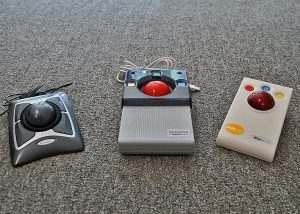
The Kinesis Maxim opens at various angles allowing users to use the keyboard at angles that are easier on the wrist.
At first glance, the Kinesis Maxim may look like any other keyboard. Divided in two, each half can be adjusted to multiple positions. This three-dimensional adjustment capability accommodates a wide range of postures resulting from physical disabilities and physiological disorders such as carpal-tunnel syndrome. Equally important, this keyboard helps prevent the latter symptoms from occurring in the first place.

At first glance, the Kinesis Maxim may look like any other keyboard. When it opens, it shows its magic.
Here’s the trick: the keyboard can be split right down the middle. The left- and right-hand halves can be separated up to 30 degrees; in addition, each half can be tilted away from the other at an angle up to 14 degrees, like a “tent,” according to the manufacturer. This splayed design positions your wrist and hand in a neutral posture. With a regular standard (flat) keyboard, the wrists twist while the fingers press the letter keys. By positioning the two halves at various angles, the wrists are kept straight according to the physical build of the user. The Kinesis Maxim is one of several ergonomic keyboards we have used. It is an excellent companion to a range of ergonomic and rollerball mice.
Several people who have reviewed and liked the Maxim and other Kinesis keyboards speak very unfavorably about the Microsoft Sculpt Ergonomic and 4000. (Those keyboards will be discussed later on in this space.) It is worth noting, however, that the “best choice” is really a matter of individual needs and comfort. At our Technology Lending Center, we have these and other keyboards available to try out, either on site or at home, on loan. That way, one can compare the options side by side, to determine what works best. And this service is free to New Jersey residents.

Three examples of trackball mice that serve people with disabilities (left to right): Kensington Expert Mouse, Traxsys Roller II, AbleNet Wave

These three mice offer ergonomic comfort: (form left to right) the AirO2bic mouse, Evoluent Vertical Mouse, and HumanScale Whale Mouse.


